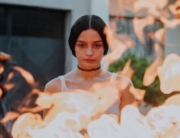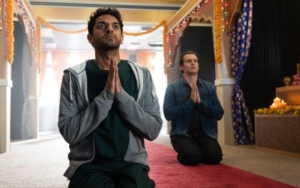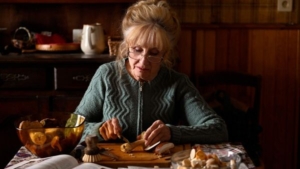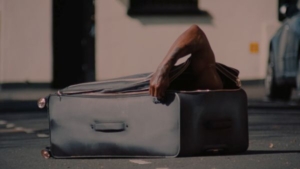
Ben Affleck and Rachel McAdams in TO THE WONDER (All photos: Venice Film Festival)
South Korean director Kim Ki-duk’s monochromatic, blood-soaked Jacobean tale of revenge and forgiveness, Pieta, won the Golden Lion award last weekend during a chaotic awards ceremony televised live on the RAI Cinema channel. It triumphed over several richer films, like Ulrich Seidl’s comedy of cruelty, Paradise: Faith, and Terrence Malick’s To the Wonder (far from flawless, but just let the cinematography seduce you). The favorite competing film, based on word of mouth, was Paul Thomas Anderson’s The Master, with Philip Seymour Hoffman and Joaquin Phoenix sharing the best actor prize and Anderson winning best director. Initially, Anderson was awarded the Grand Jury Prize, but during Seidl’s acceptance speech for best director, jury member Laetitia Casta stepped forward to say a mistake had been made. The wrong awards were given out. Hoffman, who had accepted Anderson’s award, came back on and switched honors with Seidl.
Pieta’s victory felt like a compromised choice. According to various reports, the jury wanted to honor The Master with three awards, but, due to the festival’s restrictive rules (only two major awards maximum per film), it could only award it with two prizes. However, Pieta’s narrative was the most efficient in the competition: a high-tone genre film with plenty of shocking moments between a robotic, lethal loan collector and the woman stalking him. She swears to him that she’s his mother, and he makes her prove her devotion through a lot of stomach-turning trials. Just a hint: there’s a lot of masturbation in this and in other competing films.
Speaking of which, one such scene caused the schematic but indelible Paradise: Faith to come under fire even before its official screening—maybe a large wooden crucifix as the pleasuring aide had something to do with the outcry. This is not a spoiler, by the way. You know from the opening moment that it’s only a matter of time before Christ will be violated; the film begins as a 40-ish woman with a severe Princess Leia-like hairstyle kneels before the crucifix, which tellingly hangs over her bed. She disrobes, picks up a knotted leather whip, and spends at least a minute flagellating herself. Feeling purged, she stops and thanks Jesus.
The penitent Anna might be considered a cafeteria Catholic: she picks and chooses her doctrines according to a severe pre-Vatican Council II, pre-Reformation diet: all starch. She belongs to the Legion of the Sacred Heart, whose declared mission is to return Austria to Roman Catholicism. On a summer vacation from her nursing job, she travels door to door with a statue of the Virgin Mary, targeting mostly immigrants with the greeting, “The mother of God has come to visit you.” These strange encounters are the only strained vignettes of the film—why would anyone let her in or engage her in a serious debate?
The director takes an unflinching look at self-absorbed human behavior, and like in his previous films, he films with a signature style of long takes that firmly root his characters in their environment, in this case a rather sterile, depopulated suburb. Nowhere does he address doctrinal issues or ideas. It’s how Anna personally chooses to express and use her faith that concerns him. She has a childlike or simplistic belief: if she performs certain rituals and acts in a certain way, she’ll atone and have peace of mind. But from what? The film evolves into the darkest of droll comedies when she returns home from proselytizing and finds her wheelchair-bound Muslim husband, who has been absent for two years, in her living room.
With two obstinate shut-ins sabotaging each other, the setup’s like a violent post-9/11 Who’s Afraid of Virginia Wolff? (During the ensuing tit-for-tat retaliations between the sparing couple, the husband smashes the photo of the current pope to loud applause at the press screening; audiences will read into it what they will.) At first, the husband appears as a voice of reason, chiding Anna’s intolerance and offering a chance to reunite, but this notorious director takes no half-measures. In one of several intense moments (to put it mildly), the husband nearly rapes his wife.
The film forms the second part of a trilogy, beginning with Faith: Love, which premiered this year at Cannes and focuses on Anna’s sister on a sex holiday in Kenya. Each stands alone. However, at nearly two hours, the film over-illustrates Anna’s excessive behavior, which includes reciting the rosary while treading on her knees room to room in her simply furnished apartment, and some of the confrontations are too obvious. In a scene centering on Anna’s aversion to the needs of the body (meaning sex), she stumbles upon a group of swingers going at it in a public park, and she flees in fright. However, actress Maria Hofstätter’s conviction makes you believe you are watching a documentary. I thought for sure her vanity-free, audacious performance would win best actress at the festival. This confrontational film seems right up the alley of jury member Marina Abramovic.
Terrence Malick plunges back into the languid, meditative vibe of The Tree of Life with To the Wonder, which again ponders the meaning of existence. Again, one beautiful image glides into another. It even includes footage that he couldn’t squeeze into the previous film, and it feels as improvised and rambling as it drifts from idea to idea, again with Wagner on the soundtrack, Parsifal this time. I suppose it’s about the search for beauty or purpose in the every day, and cinematographer Emmanuel Lubezki certainly makes the here and now mesmerizing. This may be the only film where Oklahoma has ever looked as stunning as France. This elusive film’s all about immersion. Immersion in a love affair for the film’s two female leads, or in a visual orgy for the viewer—and sometimes that’s all a viewer wants, though the long-winded, introspective narration is superfluous (you might be reminded of a Calvin Klein ad).
A taciturn Ben Affleck plays the one character interwoven throughout film, first involved with a French single mother (Olga Kurylenko) and later a hometown girl from his past (Rachel McAdams). The film comes to life when McAdams appears on the screen; she oozes with vulnerability. The film takes on an importance, and what happens palpably matters. In just one of the film’s enduring images, the honey-blond McAdams saunters in a golden wheat field in a rich scarlet dress, shot probably during sunrise. She’s given the full goddess treatment. Sadly, she’s only in the film for 15 minutes. But one hopes that Affleck was directed to be diffident. The women act circles around him while more often than not he lurks in the background.

Joaquin Phoenix in THE MASTER
After the first opening days, an uneven roster of films caused expectations to soar through the roof for The Master. It became the front runner for the Golden Lion by default, although as the packed press screening progressed, the audience became a little restless. Whether it’s about Scientology is beside the point; Anderson focuses on the symbiotic relationship between two very different but both equally infantile men. In the early 1950s, Philip Seymour Hoffman’s Lancaster Dodd formulates an iconoclastic belief in past spirits living on in our bodies, using similar but not quite the same terminology as L. Ron Hubbard’s Dianetics. Live wire Freddie Quell (Joaquin Phoenix in a tightlipped, mumbling, lumbering performance) becomes Dodd’s accidental right-hand man.
After his war service fighting the Japanese, Freddie travels cross country, taking menial job after another until he drunkenly stumbles upon Dodd’s boat docked in the San Francisco Bay and stows away on it. He transfers his services from Uncle Sam to Dodd, becoming an attack dog, furiously assaulting any critic poking holes in the group’s philosophy (which isn’t hard to do). From the beginning, Phoenix’s Freddie lives on a liquid diet of his homebrewed moonshine—the key ingredient gasoline or paint thinner, anything he gets his hands on. He cares less for the mind than he does for the body. All he wants is to drink and have sex. He’s a walking contradiction of Dodd’s mantra “Man is not an animal.”
The ghost of There Will Be Blood lingers in the background, except this time around there are two antisocial megalomaniacs descending into their own insular, myopic forms of crazy. However, there’s a major difference. Anderson steadily put Daniel Day-Lewis through his paces in Blood, building suspense through multiple subplots. Here, both men are nuts from the get-go and don’t let up. The audience already has their number even while the film has yet another hour to go. It’s difficult to call this story a tragedy when both men are oblivious, single-minded, and incapable of self-reflection.
Both performances unleash over-the-top behavior. Freddy rants, and the louder Dodd pontificates, the more he shouts down dissent. The movie’s like sitting through one long class at the Actors Studio. It may be a cathartic breakthrough for the actors, but not the audience. There are riveting moments when Dodd flips out, and like in Blood, the most involving scenes are simply filmed one-on-one confrontations. However, only one sequence surprises: Dodd capers to an English ditty at a party, surrounded by female followers, who, suddenly with an edit, appear nude.
On the surface, Dodd’s latest wife, Peggy, is a loyal early-1950s housewife who never upstages her husband, but scene after scene she reveals hidden and unyielding facets—she’s the strategist behind the cult. When Freddie breaks into an apartment and beats up a skeptic, the moment confirms what you expect from him, but a scene where Peggy pragmatically offers her husband marital advice will change your perception of Peggy and the actress playing her. This role offers something new and dangerous for Amy Adams.
More than 1400 feature films were submitted for this year’s edition, and because artistic director Alberto Barbera had slimmed down the number of films in the official selection to only 50 (all world premieres), I had perhaps higher expectations from the curated programming. However, there were a few high-profile misfires: Rahim Bahrani’s At Any Price, a cornpone and predicable Arthur Miller-esque family drama set on an Iowa farm in which the director obliterates any subtlety from his art-house films (Man Push Cart, Chop Shop). Dennis Quaid plays a seed salesman with such desperation that he scares off his customers and the audience. I assumed Bahrani’s venture into the mainstream was chosen because his Goodbye Solo was greeted to acclaim in Venice in 2008, and this would be like a favorite son returning home.

Kad Merad in SUPERSTAR
The wan media satire from France, Superstar, had the misfortune of debuting months after Woody Allen’s To Love With Rome, where another wallflower schlub miraculously becomes a media sensation. A YouTube video of balding, middle-aged Martin Kazinski (Kad Merad, with his charisma deliberately set on mute) simply walking down a street draws hundreds of thousands of viewers within hours. And just as suddenly as the public becomes enamored of him, they turn against him.
Director Xavier Giannoli heads into Network waters, with a “I’m mad as hell and I’m not going to take it anymore” moment and an ambitious female television executive riding the coattails of the public’s fascination with Kazinski. However, Network’s Faye Dunaway would have eaten Superstar’s Cécile de France for breakfast and quickly forgotten about it. The prescient Network was way ahead of the curve, even predicting reality TV, while Superstar is just catching up.
Loaded with literate dialogue, Olivier Assayas’s Something in the Air is the type of film that is easily labeled “cerebral”—his characters don’t have to get stoned to become philosophical. It’s set in 1971 with the spirit of change from May 1968 inspiring a coterie of university students/political activists. Assayas’s loose and fluid narrative packs in a lot of incidents: an opening riot scene, a security guard falling into a coma, a police investigation, and a drug overdose. Yet the film feels remote, as though there’s an insurmountable wall between the audience and the screen. There’s no fallout, let alone emotional resonance, onscreen from what happens, and little registers with the characters, who exist in a haze. It’s a subdued portrayal of youthful idealism, even with surging hormones. However, it has a great soundtrack: Syd Barrett-era, Booker T & the MG’s, Nick Drake, among others.
My favorite films numbered about the same as the disappointments, which is par for a festival where all of the films are debuts and going to any screening is a leap of faith. However, the paucity of “middle” films is puzzling: films that are solidly made, successful at what they attempt to accomplish in a manner that might depart from the tried and true. It makes me reevaluate other such recent events, like the Tribeca Film Festival or the BFI London Film Festival, where there have recently been more such discoveries, and question whether Venice’s programming reflects a certain philosophy, geographic sensitivity, or taste. Or maybe it’s cyclical, the luck of the draw.
















Leave A Comment